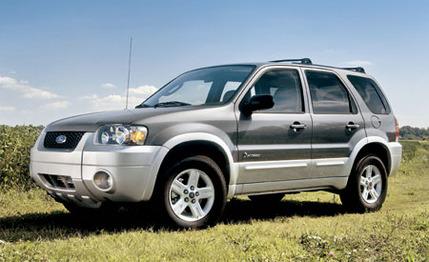 Road Test
Road Test
By industry standards, it takes an American automaker about three years to turn out a new car. That fact may have people wondering why it's taken Ford five years and 100 engineers to successfully install a hybrid drivetrain in an existing vehicle, the Escape SUV. Whatever the reason, the baby is a year overdue but has finally arrived.
The Escape now joins a burgeoning array of hybrids from Toyota and Honda. This first Ford hybrid follows the technology path of the Toyota Prius by combining an efficient gasoline engine with not one but two electric motors. The gas engine is the base Escape's 2.3-liter four, which has been modified to run on the Atkinson cycle. The specifics of the Atkinson cycle can get a little complicated, but basically, it takes in less air-fuel mixture than when running on the conventional Otto cycle (what almost all gas engines use) in exchange for a greater expansion ratio. So although it's more efficient-and thus increases fuel economy-it makes less power simply because it inhales less air and fuel. Power drops from 153 to 133 horsepower and torque from 152 to 129 pound-feet. The benefit of having two electric motors-one driving the wheels and the other used to start the engine and spread the transmission's ratios-amounts to improved fuel economy in city driving and some extra thrust to bolster the efficiency-biased four-banger. Two motors and a planetary-type continuously variable transmission (CVT) permit the Escape and the Prius to be driven via electric power only, whereas no Honda can be driven this way. Further, the dual-motor scenario is more efficient at capturing energy since one of the electric motors is connected directly to the wheels.
The electric motors are powered by a 330-volt battery pack that resides beneath the Escape's load floor. The battery is charged in two ways: regeneratively, capturing energy during braking, or via the gas engine.
Unlike the pioneering Honda Insight hybrid, the Escape doesn't come with any purpose-built hybrid tricks-there are no extremely narrow, low-rolling-resistance tires and no aerodynamic teardrop shape like the Insight's.
Turning the key in the ignition starts the electric motor, which in turn fires the hybrid's gas engine. It cranks with a quiet whir and then shuts off, assuming everything is up to temperature, the battery has sufficient charge, and the climate control is in the appropriate setting. Under extremely light throttle, the electric motor will provide all the power necessary to creep around in urban traffic. In normal circumstances, the gas engine shudders to life somewhere between 10 and 20 mph to help the propulsion cause and will shut down again somewhere below 30 mph when slowing for a stop.
Inside, the differences between hybrid and gas-powered Escapes are negligible. The engine-temperature gauge has been replaced with a charge-and-assist meter. When the gas engine shuts off, the tachometer falls below the "0" level to an "EV" designation that indicates the electric motor is running the show. And the screen of the $1850 nav option provides fuel-economy and power-flow information. Unlike other hybrid makers, Ford didn't include a gauge to show how much juice remains in the battery, but there's not much the driver can do about that in any case.
The Escape wears knobby all-season rubber and punches the same hole in the air as do most tall wagons, so we were a bit curious to see if we could achieve the EPA's 33 mpg city and 29 mpg highway ratings.
We equaled that 33 mpg over about 100 miles of stop-and-go city driving and came close to the EPA highway number of 29 mpg over a 400-mile highway-only run. We never drove over 75 mph but still averaged 28 mpg, 1 mpg short. There's no reining in the speed merchants around here, so the Escape's stay with us produced a fuel-economy average of just 25 mpg over its entire 1600-mile stay. By comparison, two V-6 Escapes and a Tribute that passed through our hands previously have scored overall averages ranging from 17 to 21 mpg. From 17 to 25 mpg is a whopping 47-percent improvement, and 21 to 25 is a still-impressive 19-percent gain.
Speaking of costs, our hybrid Escape was delivered with an eye-bulging $32,450 price tag. Ford compares this hybrid with a well-equipped V-6 model, so that big number is the result of a $3000 hybrid premium and $3855 worth of options, including navigation, leather seats, and extra airbags. Discount shoppers can delete four-wheel drive to save $1625 but will still pay the extra $3000.
For comparison purposes, we acquired a nonhybrid 2.3-liter four-cylinder Escape with four-wheel drive, an automatic, and a bargain price of $23,235. The EPA projects that the conventional Escape will deliver 19 mpg city and 22 mpg highway. Using the same city and highway loops, we got 22 and 26, respectively, but netted a so-so 20 mpg when we put it in the hands of the office leadfoots. What we concluded, however, is that its 14.7-second 0-to-60 time and 20.1-second quarter-mile trip make it a shoe-in for the worst acceleration numbers we've seen this year.